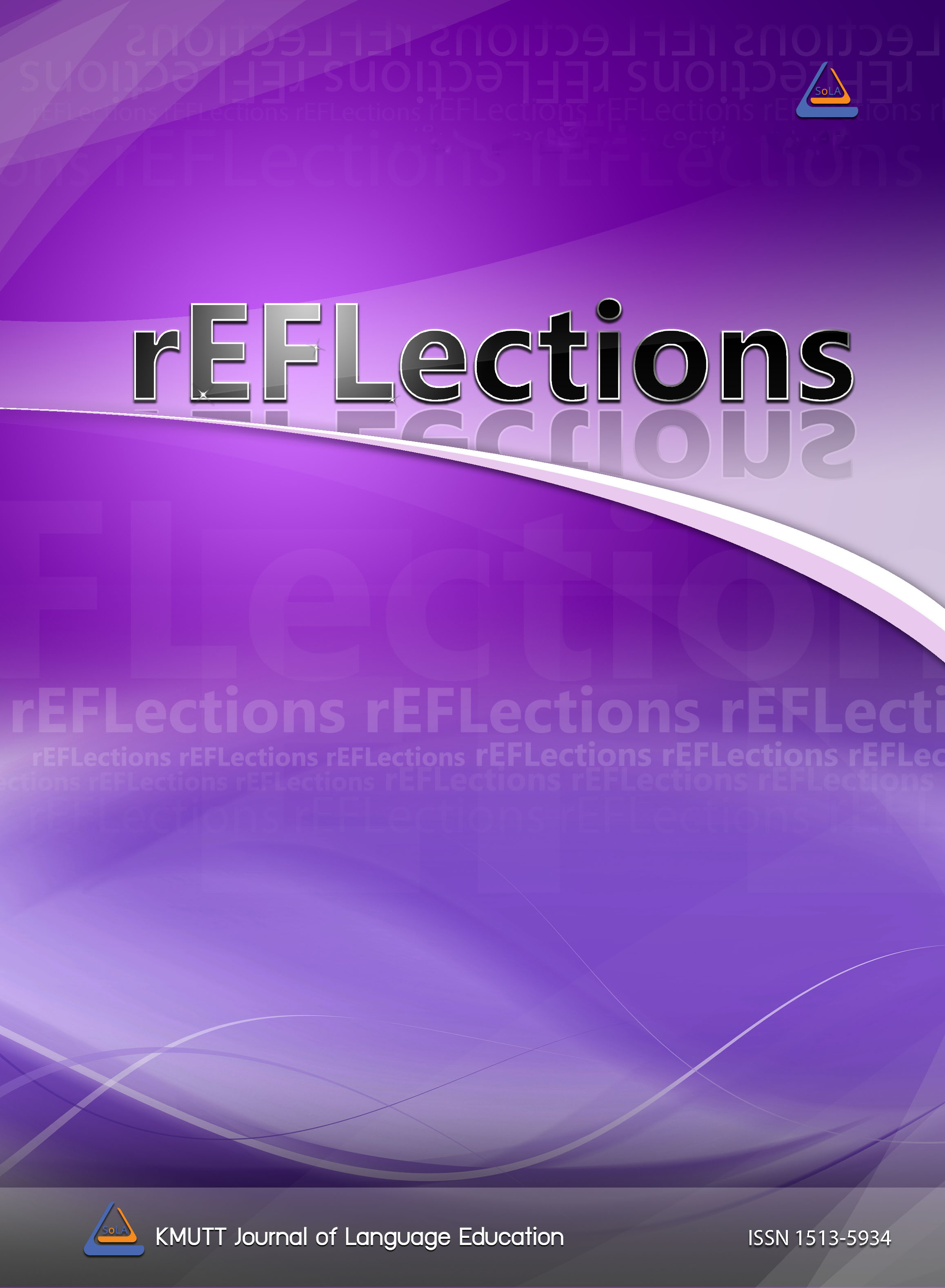“Read It Like You Mean It”: Developing Prosodic Reading Using Reader’s Theater
Main Article Content
Abstract
Prosody is a linguistic feature in spoken English that is complex yet plays an important role in oral communication. Nevertheless, many EFL pronunciation classes in Thailand have not adequately emphasized the importance and functions of prosody to learners. This research study aims to investigate effect of an oral fluency instructional method called Reader’s Theater on Thai EFL university students’ perception and production of the prosodic features of pausing and sentence final intonation. The participants of this study are 22 Thai university students majoring in English. The results revealed that the students’ perception of these prosodic features increased and that the production of prosody shows correlation with comprehensibility. These results also suggest that effective modelling of oral fluency as an input is crucial to the perception of learners, and ultimately that prosody should be implemented in pronunciation classes in the EFL curriculum.
Article Details
References
Alspach, S. (2010). The effects of reader’s theater on fluency of elementary students with learning disabilities. (Master’s thesis). Ohio University, USA. Retrieved from https://www.ohio.edu/education/academicprograms/teacher-preparation/department-of-teacher-education/masters-programs/loadercfm?csModule=
security/getfile&PageID=2185233
Barchers, S., & Kroll, J. L. (2002). Classic reader’s theatre for young adults. Greenwood Village, CO: Teacher Ideas Press.
Callard, K. (2008). Using reader’s theater to increase third graders reading fluency, comprehension, and motivation (Doctoral dissertation). Nova Southeastern University, USA. Retrieved from https://www.researchgate.
net/publication/239925549_Using_Reader%27s_Theater_to_Increase_ThThi_Graders%27_Reading_Fluency_Comprehension_and_Motivation.
Cutler, A., Oahan, D., & van Donselaar, W. (1997). Prosody in the comprehension of spoken language: a literature review. Language and Speech, 40(2), 141-201.
Derwing, T. M., & Munro, M. J. (2005). Second language accent and pronunciation teaching: a research-based approach. TESOL Quarterly, 39(3), 379-397.
Derwing, T. M., & Rossiter, M. J. (2003). The effects of pronunciation instruction on the accuracy, fluency, and complexity of L2 accented speech. Applied Language Learning, 13(1), 1-17.
Dougill, J. (1987). Drama activities for language learning. New York, NY.:Macmillan.
Gilakjani, A. P., & Sabouri, N. B. (2016). Why is English pronunciation ignored by EFL teachers in their classes?. International Journal of English Linguistics, 6(6), 195-208.
Hardison, D. M. (2004). Generalization of computer-assisted prosody training: quantitative and qualitative findings. Language Learning & Technology, 8, 34-52.
Haws, J. (2008). Fluency and Reader’s Theater. Unpublished research, Virginia Beach City Public Schools, Virginia. Retrieved from http://www.vbschools.com/accountability/action_research/JenniferHaws.pdf
Hudson, R. F., Lane, H. B., & Pullen, P. C. (2005). Reading fluency assessment and instruction: What, why, and how?. The Reading Teacher, 702-714.
Kettongma, N., & Wasuntarasobhit, S. (2015). Effects of prosodic feature and cognitive listening strategy instruction on low-intermediate EFL learners’ listening comprehension. KKU Research Journal of Humanities and Social Sciences HS, 3(3), 65-83.
Lekwilai, P. (2014). Reader’s Theater: An alternative tool to develop reading fluency among Thai EFL learners. PASAA, 48, 89-112.
Lekwilai, P. (2016). Using Reader’s Theater to develop reading fluency among Thai EFL students. Pasaa Paritat, 31, 163-188.
Lennon, P. (1990). Investigating fluency in EFL: A quantitative approach. Language Learning, 40(3), 387-417.
Levis, J. M., & Pickering, L. (2004). Teaching intonation in discourse using speech visualization technology. System, 32, 505-524.
Liu, J. (2000). The power of readers’ theater: from reading to writing. ELT Journal, 54(4), 354-361.
McKay, M. (2008). Readers theater – take another look – it’s more than fluency instruction. LEARNing Landscapes, 2, 131-144. Retrieved from http://173.246.64.12/images/documents/ll-no3-nov08-final-lr-links.pdf#page=131
Martinez, M., Roser, N. L., & Strecker, S. (1998). “ I never thought I could be a star”: A Readers Theatre ticket to fluency. The Reading Teacher, 326-334.
Mennen, I., & de Leeuw, E. (2014). Beyond segments: prosody in SLA. Studies in Second Language Acquisition, 36, 183-194.
Nation, P. (2009). Reading faster. International Journal of English Studies, 9(2), 131-144.
National Reading Panel (2000). Teaching children to read: An evidence-based assessment of the scientific research literature on reading and its implications for reading instruction: Reports of the subgroups. U.S. Department of Education. Retrieved from https://www.nichd.nih.gov/publications/pubs/nrp/documents/report.pdf.
Rasinski, T., & Padak, N. (2000). Effective reading strategies: Teaching children who find reading difficult (2nd edition). Upper Saddle River, N.J.: Merrill.
Rasinski, T. V. (2004). Assessing reading fluency. Honolulu, HI: Pacific Resources for Education and Learning.
Rinehart, S. (1999). “Don’t think for a minute that I’m getting up there”: Opportunities for readers’ theater in an tutorial for children with reading problems. Journal of Reading Psychology, 20, 71-89. Retrieved from http://www.tandfonline.com/doi/abs/10.1080/027027199278510?journalCode=urpy20#.UzZrkPmSxx0
Trainin, G., & Andrzejczak, N. (2006). Readers’ Theatre: A viable reading strategy. University of Nebraska, Lincoln, NE: Great Plains Institute of Reading and Writing.
Tanner, M. W., & Landon, M. M. (2009). The effect of computer-assisted pronunciation readings on ESL learners’ use of pausing, stress, intonation, and overall comprehensibility. Language Learning & Technology, 13, 51-65.
Tennant, A. (2007). Sounds Reasons for Teaching Pronunciation. Retrieved from: http://www.onestopenglish.com/skills/pronunciation/pronunciationmatters/pronunciation-matters-sound-reasons-for-teachingpronunciation
/155507. article
Samuels, S. J. (1979). The method of repeated readings. The Reading Teacher, 32(4), 403-408.
Srimalee, P., & Charubusp, S. (2018). The use of reader’s theater in extensive reading to enhance Thai students’ reading motivation. NIDA Journal of Language and Communication, 23(33), 43-66.
Ur, P. (1984). Teaching listening comprehension. New York, NY.: Cambridge University Press.
Young, C., & Rasinski, T. (2009). Implementing readers theater as an approach to classroom fluency instruction. The Reading Teacher, 63(1), 4-13.
Zhang, S. (2009). The role of input, interaction and output in the development of oral fluency. English Language Teaching, 2(4), 91-100.
Zutell, J., & Rasinski, T. V. (1991). Training teachers to attend to their students’ oral reading fluency. Theory Into Practice, 30(3), 211-217.


